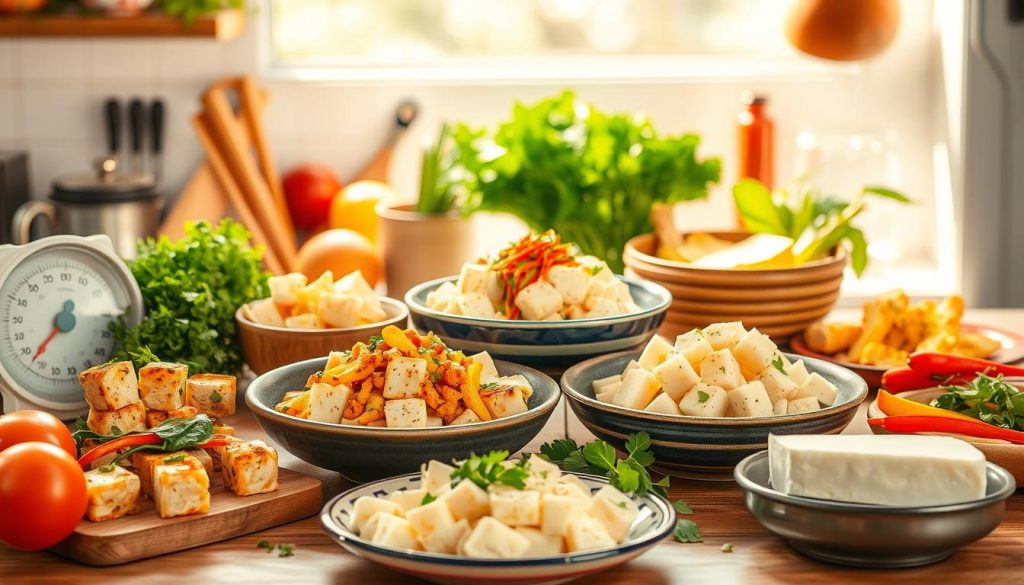Oxalate in Tofu: What You Should Know About Soy Foods
Tofu is a popular protein source in many diets. But, have you thought about the oxalate in tofu? This soy-based food has different amounts of oxalates, which are found in many plants. Knowing how much oxalate is in tofu is key for those who eat soy foods often.
How soybeans are processed into tofu can change its oxalate levels. Soy foods are good for health, but knowing their oxalate levels is important. This article will look at how oxalates and tofu relate, discuss health effects, and give tips on eating soy while managing oxalates.
Oxalates help plants grow and develop. They are in many foods, not just soy. For example, taro, a root from Southeast Asia, is full of oxalates. It must be cooked well before eating. Knowing about oxalates in different foods helps you make better food choices.
Key Takeaways
- Tofu contains varying levels of oxalates, which are naturally occurring compounds in many foods.
- Processing methods can affect the oxalate content in soy foods.
- Understanding oxalate levels is important for those with certain health conditions.
- Oxalates play a role in plant growth and are found in many foods beyond soy.
- Proper cooking techniques can help manage oxalate intake while enjoying soy products.
Understanding Oxalates and Their Role in Human Health
Oxalates are compounds found in many foods we eat. They are important for our health, especially for our kidneys and how we absorb nutrients. Let’s explore what oxalates are and how they affect us.
What Are Oxalates?
Oxalates are molecules in plants. They can combine with minerals like calcium in our stomach. This can sometimes cause health problems, especially for those who get kidney stones.
Natural Sources of Oxalates
Many healthy foods have oxalates. Foods like spinach, nuts, and some legumes are high in oxalates. Soy products, such as tofu, also have oxalates. It’s key to remember that not all oxalate and soy products are the same – their levels can differ.
| Food | Oxalate Content | Protein (g) | Potassium (mg) |
|---|---|---|---|
| Flax seeds | Low | 3 | 114 |
| Chia seeds | High | 4 | 106 |
| Spinach | Very High | 2.9 | 839 |
How Oxalates Impact Body Functions
Oxalates can impact our bodies in several ways. They might block mineral absorption, leading to nutrient deficiencies. High oxalate intake can also increase the risk of kidney stones. About 60% of women get urinary tract infections, which might be linked to oxalate levels.
While oxalates can be challenging, they’re not entirely bad. Many foods high in oxalates are also full of nutrients. The important thing is finding a balance and knowing what your body needs, especially if you’ve had kidney stones or other health issues.
Oxalate in Tofu: A Comprehensive Analysis
Tofu, a soy-based food, has different amounts of oxalate. This depends on how it’s made and what type it is. Knowing this is key for those watching their oxalate intake.
Several things affect tofu’s oxalate levels. The coagulants used and the tofu’s firmness are important. Softer tofu usually has less oxalate than firmer types.
Recent studies show that how soybeans are processed changes tofu’s oxalate levels. Traditional methods often lead to less oxalate than newer ones. This shows why knowing how tofu is made matters for its nutrition.
“The oxalate content in tofu can vary greatly depending on the production process, making it crucial for consumers to be aware of their choices,” says Dr. Emily Chen, a nutrition expert specializing in plant-based diets.
If you’re on a low oxalate diet, watch your portion sizes and how often you eat tofu. Tofu can be good in a balanced diet. But, if you’ve had kidney stones or other oxalate issues, talk to a doctor about eating tofu.
| Tofu Type | Oxalate Content | Recommended Serving Size |
|---|---|---|
| Silken Tofu | Low | 1/2 cup |
| Firm Tofu | Moderate | 1/4 cup |
| Extra Firm Tofu | High | 1/8 cup |
Knowing about tofu’s oxalate content helps you make better food choices. By looking at how it’s made and the type, you can enjoy tofu while keeping your oxalate intake in check.
The Processing of Soybeans and Its Effect on Oxalate Levels
Making tofu from soybeans is a process that changes the food’s properties. This includes how much oxalate is in it. We’ll look at how different methods affect oxalate levels in tofu and soy products.
Traditional vs. Modern Processing Methods
Old methods of making tofu often leave more oxalates. Newer methods might reduce them. For instance, longer soybean soaking can lower oxalate levels. Some producers now use tools to remove more oxalates during processing.
How Manufacturing Affects Oxalate Content
The tofu-making process is key. Using different substances to curdle soy milk can change oxalate levels. Heat also plays a role. Higher temperatures can break down some oxalates. But too much heat can make the tofu less tasty.
Different Types of Tofu and Their Oxalate Variations
Not all tofu is the same when it comes to oxalates. Soft tofu generally has fewer oxalates than firm tofu. This is because it has more water and less soy. Here’s a quick look at oxalate levels in various tofu types:
| Tofu Type | Oxalate Content (mg per 100g) |
|---|---|
| Silken Tofu | 7-10 |
| Soft Tofu | 10-13 |
| Firm Tofu | 13-15 |
| Extra Firm Tofu | 15-18 |
Knowing these differences helps you choose the right tofu for your needs. If you’re watching your oxalate intake, softer tofu might be a better choice.
Comparing Oxalate Levels in Different Soy Products
Soy products have different amounts of oxalates. It’s key for those watching their intake to know these differences. Tofu, a favorite soy food, has moderate oxalate levels. Other soy foods like tempeh, edamame, and soy milk have varying amounts.
Fermented soy products tend to have less oxalates because of the fermentation process. Knowing this helps those balancing soy with oxalate intake. It’s especially helpful for those following certain diets.
| Soy Product | Oxalate Content (mg per 100g) | Serving Size |
|---|---|---|
| Tofu (firm) | 13 | 1/2 cup |
| Tempeh | 9 | 1/2 cup |
| Edamame | 5 | 1/2 cup |
| Soy milk | 2 | 1 cup |
Knowing about oxalates in soy helps make better food choices. For those worried about high oxalate foods, it might be wise to limit some soy products. Yet, it’s crucial to remember that some soy foods are high in oxalates but also rich in nutrients. They can be part of a healthy diet if eaten thoughtfully.
When adding soy to your meals, think about the oxalate content and other benefits. This way, you can enjoy soy’s health perks while keeping oxalate intake in check.
Health Implications of Consuming High-Oxalate Foods
Eating foods high in oxalates can affect your health in many ways. It’s key to understand these effects to make smart food choices. This is especially true for foods like tofu.
Kidney Stone Formation Risk
Eating too much oxalate can raise your risk of getting kidney stones. Oxalates combine with calcium in urine, forming crystals that can turn into stones. If you’ve had kidney stones before, watch your oxalate intake closely.
Mineral Absorption Concerns
Oxalates can block the body’s ability to absorb important minerals. They tie up calcium, iron, and other nutrients in the gut. This can lead to deficiencies, especially for those at risk of osteoporosis or anemia.
Population Groups at Higher Risk
Some groups are more affected by dietary oxalates:
- People with a history of kidney stones
- Those with certain metabolic disorders
- Individuals with digestive issues that affect oxalate absorption
- People on specific medications that alter oxalate metabolism
While soy foods like tofu are healthy, consider your health and risks. If oxalate absorption worries you, talk to a healthcare expert for advice.
Benefits and Risks of Tofu Consumption
Tofu is a great source of plant-based protein. It’s full of important nutrients and can be a good choice for many diets. If you want to increase your calcium intake, try tofu made with calcium sulfate. It’s a great way to get more calcium, which is key for strong bones and teeth.

But, tofu also has oxalates, which can be a problem for some. If you’re sensitive to oxalates or have had kidney stones, watch how much tofu you eat. Oxalates can take calcium away from your body, which might harm your bone health.
It’s important to weigh the good and bad of eating tofu. For most, eating tofu in moderation is safe. But, if you have certain health issues, talk to a doctor about tofu. Knowing the benefits and risks helps you decide if tofu is right for you.
- Rich in plant-based protein
- Good source of calcium when made with calcium sulfate
- Contains essential nutrients
- May pose risks for those with oxalate sensitivity
- Moderate consumption recommended for most people
Managing Oxalate Intake While Enjoying Soy Foods
It can be hard to balance a low oxalate diet with soy foods. But don’t worry! There are ways to enjoy tofu and other soy products while managing oxalate intake. Let’s explore some helpful strategies.
Preparation Methods to Reduce Oxalates
Cooking techniques can lower oxalate levels in soy foods. Soaking tofu in water for a few hours before cooking can help. Boiling is another effective method. It can reduce oxalate content by up to 30-50%. For tempeh, try fermenting it longer. This process breaks down oxalates naturally.
Balanced Diet Strategies
A key part of managing oxalate intake is balance. Mix high-oxalate foods with low-oxalate options. For example, pair your tofu stir-fry with low-oxalate veggies like cauliflower or zucchini. Drinking calcium-rich beverages with meals can also help. Calcium binds to oxalates in the gut, reducing absorption.
Portion Control Guidelines
Moderation is crucial when including soy in a low oxalate diet. Stick to smaller portions of tofu, about 1/2 cup per serving. If you’re having tempeh, aim for a 3-ounce portion. Spread your soy intake throughout the week rather than consuming large amounts at once.
| Soy Food | Recommended Portion | Frequency |
|---|---|---|
| Tofu | 1/2 cup | 2-3 times per week |
| Tempeh | 3 ounces | 1-2 times per week |
| Edamame | 1/4 cup | 1-2 times per week |
By following these guidelines, you can enjoy the benefits of soy while maintaining a low oxalate diet. Remember, everyone’s needs are different. It’s always best to consult with a healthcare professional for personalized advice on managing your oxalate intake.
Alternative Low-Oxalate Protein Sources
For those on a low oxalate diet or with oxalate sensitivity, finding protein-rich foods can be challenging. Luckily, there are many tasty options that won’t spike your oxalate levels.
Lean meats like chicken and turkey are excellent choices. They’re packed with protein and contain virtually no oxalates. Fish, especially salmon and cod, offer heart-healthy omega-3s along with their protein punch.
Eggs are another versatile, low-oxalate protein source. They’re easy to prepare and can be enjoyed in countless ways. For plant-based options, certain legumes like lentils and green peas are lower in oxalates compared to other beans.
Some nuts and seeds can also fit into a low oxalate diet. Flax seeds are a great example. Two tablespoons of ground flax seeds provide:
- 3g of protein
- 90mg of phosphorus
- 114mg of potassium
Best of all, they’re low in oxalates. On the other hand, chia seeds, while nutritious, are high in oxalates and should be consumed cautiously if you’re sensitive.
Remember, balance is key. Incorporating a variety of these protein sources can help you maintain a nutritious diet while managing your oxalate intake.
Scientific Research on Tofu and Oxalate Content
Recent studies have shed light on tofu’s oxalate content and its health impact. Scientists are looking into how soy products might affect kidney stones. This is a big concern for health-conscious people.
Recent Studies and Findings
Research shows tofu’s oxalate levels change with processing. A study in the Journal of Agricultural and Food Chemistry found soaking and cooking soybeans lowers oxalate. This is great news for those worried about tofu and kidney stones.

Clinical Evidence and Recommendations
Health experts say most people can safely eat oxalates without worry. They recommend keeping oxalate intake under 100 milligrams a day. For those at risk of kidney stones, balancing calcium and oxalate is crucial.
| Food Item | Oxalate Content (mg per serving) | Recommended Daily Limit |
|---|---|---|
| Firm Tofu (1/2 cup) | 40-50 | 100 mg |
| Silken Tofu (1/2 cup) | 30-40 | |
| Soy Milk (1 cup) | 20-30 |
Experts say genetics are a big factor in kidney stones. They suggest focusing on a balanced diet instead of cutting out tofu or soy products. Learning about smart eating can help manage health risks while enjoying foods like tofu.
Tips for Including Tofu in a Low-Oxalate Diet
Adding tofu to a low oxalate diet can be challenging. But, with smart strategies, you can enjoy this protein while keeping oxalate levels in check. Here are some useful tips to help you balance your diet:
- Choose softer tofu varieties like silken or extra-soft, which tend to have lower oxalate content
- Soak tofu before cooking to reduce oxalate levels
- Opt for boiling or steaming instead of frying to minimize oxalate concentration
- Pair tofu with low-oxalate vegetables like bell peppers, cucumbers, or zucchini
- Practice portion control by limiting tofu to 1/2 cup per serving
When planning meals, remember that balance is key. Combine tofu with calcium-rich foods to help offset potential mineral absorption issues. For example, try a tofu stir-fry with broccoli and sesame seeds, or a smoothie with silken tofu and fortified plant milk.
| Tofu Type | Oxalate Content | Recommended Serving |
|---|---|---|
| Silken | Low | 1/2 cup |
| Firm | Medium | 1/4 cup |
| Extra Firm | High | 1/8 cup |
By following these tips, you can enjoy tofu as part of a low oxalate diet without compromising your health goals. Remember to consult with a nutritionist for personalized advice on managing oxalate intake while meeting your dietary needs.
Myths and Facts About Oxalates in Soy Products
Many people worry about oxalate and soy products, but it’s time to separate fact from fiction. Let’s bust some common myths and explore the truth about oxalates in soy.
Fact: Not all soy products contain high levels of oxalates. Tofu, for example, has lower oxalate content compared to whole soybeans. The processing method affects oxalate levels in soy foods.
Myth: Soy consumption leads to kidney stones.
Fact: While oxalates can contribute to kidney stone formation, moderate soy intake is unlikely to cause issues for most people. Balanced diets that include soy may even offer health benefits.
Myth: Oxalate absorption from soy is always high.
Fact: Oxalate absorption varies. Factors like cooking methods and individual gut health influence how much oxalate your body absorbs from soy products.
“Rather than focusing on avoiding specific antinutrients, consuming a diverse array of nutrient-rich plant-based foods is more beneficial for overall health.”
Understanding these facts helps you make informed choices about including soy in your diet. Remember, moderation and variety are key to a healthy eating plan.
Conclusion
Knowing how much oxalate is in tofu and soy products is key for good food choices. Tofu is healthy, but some people need to watch their oxalate intake. This is especially true for those who get kidney stones or have certain health issues.
How soybeans are processed affects the oxalate in tofu. Old ways of making tofu have less oxalate than new methods. To lower oxalates in tofu, try soaking and cooking it. This can also help avoid losing calcium, which is important.
It’s all about finding a balance. While tofu’s oxalate might be a worry for some, soy products are full of good stuff. They have proteins, vitamins, and minerals that are good for you. Eating tofu in moderation and with other foods can help you enjoy its benefits without risks.
Whether or not to eat tofu depends on your health and what you like. Talk to a doctor or dietitian to figure out how much tofu is right for you. They can help you make a plan that fits your health goals and needs.






